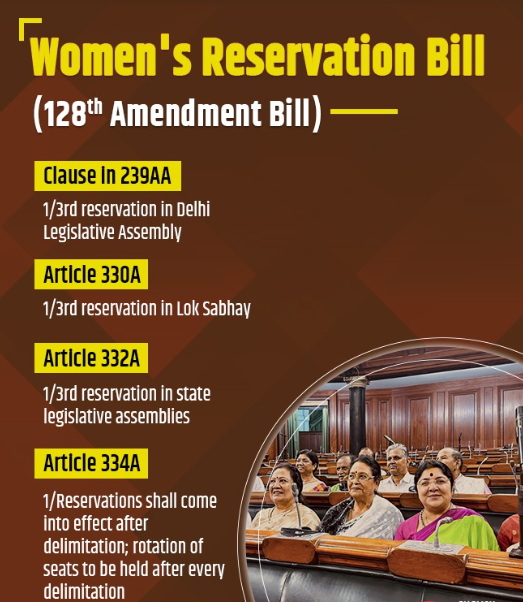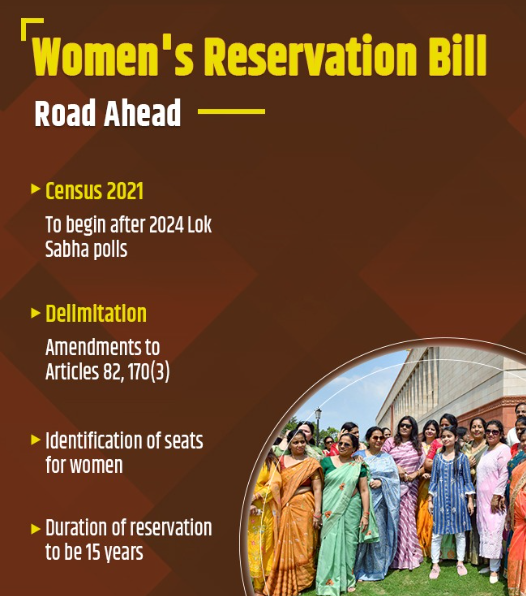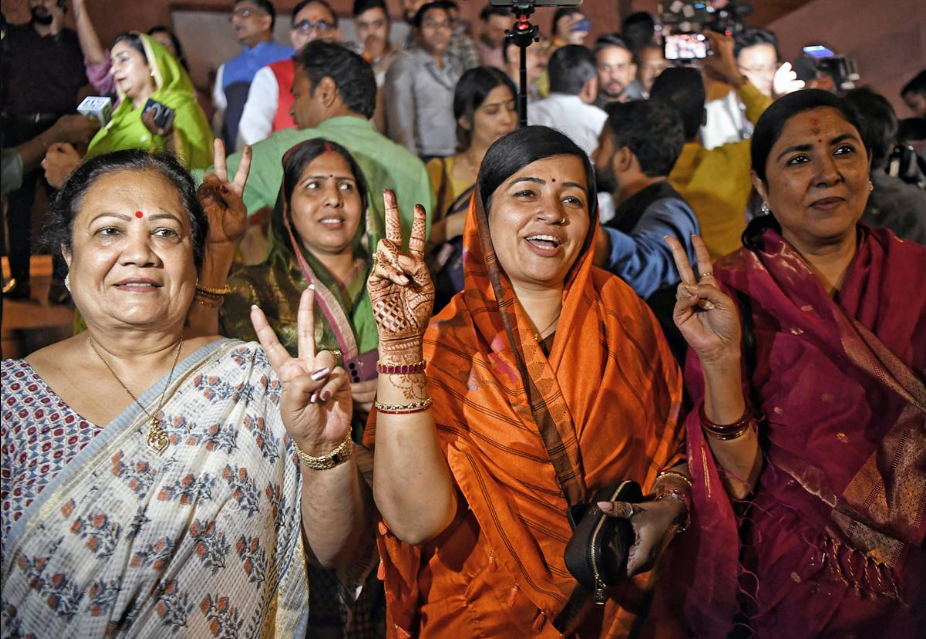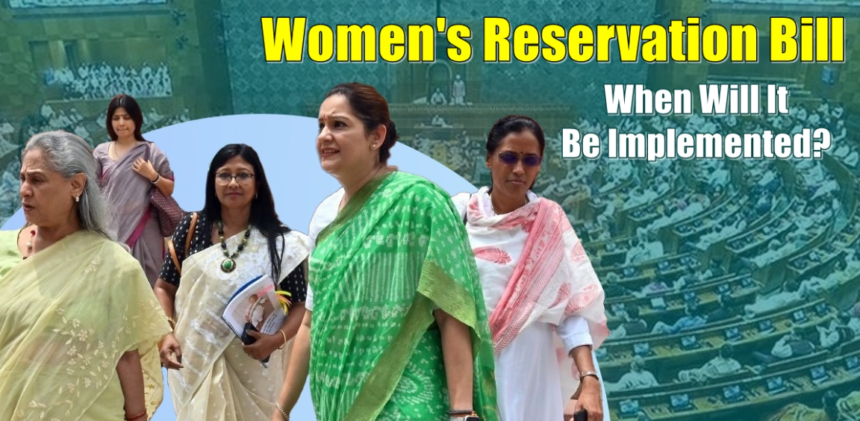Women’s Reservation Bill: The 128th Amendment Bill states that the 33% quota won’t go into force until the delineation of constituencies is done using the most recent census. According to Union Home Minister Amit Shah, the Women’s Reservation Bill won’t be put into effect until 2029.
The Women’s Reservation Bill, which the Lok Sabha approved on September 20th, has gone a long way since it was first introduced in 1996. In the lower chamber of Parliament, the Bill received a resounding victory with 454 votes in favor and just two voting against it. Although the Lok Sabha’s vote was favorable, there still seems to be a long way to go before the Bill is really put into effect. The Women’s Reservation Bill (128th amendment Bill) states that the 33% quota won’t go into force until after the delineation of constituencies is done using the most recent census, which is anticipated to happen in 2026.
Speaking during the extraordinary session of Parliament, Union Home Minister Amit Shah made it plain that the Women’s Reservation Bill would not go into effect until after 2029. Let’s examine the text of the Bill and the seat reservation procedure to have an understanding of the anticipated timescale for implementation.
Women’s Reservation Bill: What It Says

ALSO READ: All-Party Meeting: Parties Positive For Women’s Reservation Bill In Parliament Session
“Notwithstanding anything in the foregoing provision of this Part or Part VIII, the provisions of the Constitution relating to the reservation of seats for women in the House of People, the Legislative Assembly of State, and the Legislative Assembly of the National Capital Territory of Delhi shall come into effect after an exercise of delimitation is undertaken,” the Constitution (One Hundred and Twenty-eighth Amendment) Bill 2023, which seeks to reserve seats for women, states.
Amit Shah: Women’s quota only after 2029
The Opposition has questioned the Center’s motivation for presenting the Bill months before the Lok Sabha elections as the long-delayed topic of women’s reservation in legislative bodies comes up for discussion once again in Parliament. In April or May of 2024, the general elections are expected to take place. The implementation of the reservation policy won’t be achievable anytime soon, according to the opposition, who claims that the government of Prime Minister Narendra Modi is trying to trick the nation.In response to the opposition’s claim, Union Minister Amit Shah stated that regardless of their backing, the women’s reservation Bill will not go into effect until beyond 2029.
He continued, “After the [Lok Sabha] election, Census and delimitation will be done immediately and soon, the day will come when women will occupy one-third of the seats in the House and decide the future of the country.”
How seats are assigned in India

The Delimitation Act of 2002 specifies the rules for reserving the seats. According to the official Election Commission website, delimitation is the “process of fixing limits or boundaries of territorial constituencies” in a nation having a legislative body. After every census, the delimitation procedure is carried out to make sure that the demographic changes are properly taken into account at the state, Union Territory, or national levels.
The Delimitation Act calls for the establishment of the Delimitation Commission, which determines the number of reserved parliamentary and assembly constituencies based on demographic statistics.
According to their population in the relevant constituencies, the Scheduled Castes and Scheduled Tribes are currently eligible for reservation under the Constitution. According to Section 9(1)(c) of the Act, “Constituencies in which seats are reserved for the Scheduled Castes shall be distributed in different parts of the State and located, as far as practicable, in those areas where the proportion of their population to the total is comparatively large.”
Similar requirements are outlined in the Act for the reservation of seats for Scheduled Tribes. According to the law, constituencies with seats set aside for Scheduled Tribes must be situated where their population percentage to the overall population is highest, insofar as is reasonably possible.
How Will the Women’s Reservation Bill Be Implemented?
The Bill suggests adding three new Constitutional articles—330A, 332A, and 334A—as well as a clause to Article 239AA in order to provide women reservation. In contrast to the quotas granted by articles 330A and 332A in the Lok Sabha and state assemblies, respectively, 239AA provides a quota for women in the Delhi Legislative Assembly. According to these provisions, one-third of the seats designated for SCs and STs as well as one-third of all the seats in the assembly that will be elected through direct elections are designated for women.
The Bill suggests adding three new Constitutional articles—330A, 332A, and 334A—as well as a clause to Article 239AA in order to provide women reservation. In contrast to the quotas granted by articles 330A and 332A in the Lok Sabha and state assemblies, respectively, 239AA provides a quota for women in the Delhi Legislative Assembly. According to these provisions, one-third of the seats designated for SCs and STs as well as one-third of all the seats in the assembly that will be elected through direct elections are designated for women.
Once the Census results are available, a delimitation process will need to be carried out. Delimitation, a requirement for quota implementation, is carried out in accordance with Articles 82 and 170(3). The latter deals with the makeup of the Legislative Assemblies, whereas Art. 82 deals with the readjustment of constituencies following each Census. For the delimitation procedure to be implemented, both of these Articles would need to be changed.
How Will the Government Find 33% of the Seats for Women?

According to the proposed Article 334A, reservations will be put into effect after delimitation is done using the first census issued after the Bill is passed. The Article further stipulates that women’s reserved seats would be rotated following each delimitation exercise.
The Bill doesn’t go into detail about how these seats will be determined, though. According to an article by the Indian Express, a separate law is anticipated to be drafted to decide the seats. The government will be given the authority to further enact a legislation for the Women’s Reservation Bill’s implementation once it has been passed.
The UPA government has previously suggested using a lottery to determine which congressional districts should be set aside for women. The idea behind this procedure was to prevent the same constituencies from being reserved repeatedly. The rotating reservation of seats has been advocated by the current NDA administration. But it’s still unclear how the Modi administration would choose the 33% of reserved seats.
The Women’s Reservation Bill also stipulates a 15-year transition period before women’s reservations become effective. The amount of time needed to advance women’s status in political politics is calculated at this moment.
Reservations for women in Indian local organizations
According to Constitutional Article 243D, “Not less than one third (including the number of seats reserved for women belonging to the Scheduled Castes and the Scheduled Tribes) of the total number of seats to be filled by direct election in every Panchayat shall be reserved for women, and such seats may be allotted by rotation to different constituencies in a Panchayat.”
The 73rd and 74th Amendment Acts, introduced during P V Narasimha Rao’s tenure as Prime Minister, required the reservation of third seats in Panchayati Raj institutions and urban local councils. Both Acts were passed into law in 1993.
ALSO RTEAD: India vs Bharat: How Attempts To Change The Country’s Name In The Past Failed




































